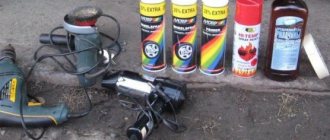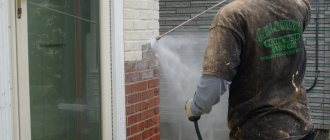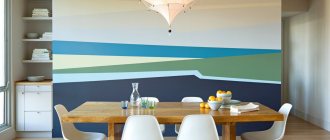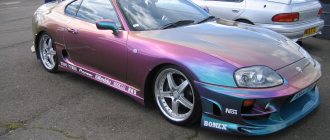Operational features of the premises
Painting walls is the most convenient and practical way of finishing. Modern paints have impressive performance properties, so they do the best job protecting surfaces. When choosing a dye, it is important to consider the following features of the room:
- The presence of direct access to the street, in this case, the requirements for the strength and heat resistance of the paint increase.
- Fire hazardous liquids and materials are constantly present in garages; non-flammable dyes are chosen.
- Dust from the street and fumes from exhausts settle on the walls; the antistatic properties of the dye will not interfere.
- High humidity from precipitation and when washing a car.
- Only a small proportion of garages have temporary or permanent heating. Paints are selected taking into account resistance to temperature changes.
- For cramped garages, you need to take into account the mechanical impact on the walls - to counteract impacts, chips and scratches.
For metal garages, dyes with corrosion protection are used. Many people try to choose non-marking colors so that stains and dirt are invisible.
Painting a concrete floor
Before painting the garage floor, you need to prepare the concrete base.
To do this, the surface is cleaned of dust and dirt, uneven areas are sealed with putty or mortar, and only then paint is applied. The paintwork should consist of 2-4 layers. The paint is applied at a temperature of the treated substrate not lower than +5˚C, ambient temperature not lower than +10˚C and air humidity not higher than 80%. Concrete floors can be painted no earlier than 5 days after pouring. The next coat of paint should be applied only after the previous one has completely dried, which is usually about 24 hours.
When choosing paints and varnishes for painting a concrete garage floor, you should definitely take into account the ability of the paint composition to withstand a wide variety of temperature changes, resistance to long-term high loads and other operating features typical of a garage.
Key requirements for paints
What dye parameters do you pay attention to when choosing:
- Compliance with the material from which the walls are made is guided by the manufacturer's recommendations.
- Moisture resistance so that the paint and walls are not destroyed by water.
- Vapor permeable to avoid condensation.
- The temperature range must correspond to the climatic characteristics of the region.
- Possibility to use detergents for cleaning.
- Fire safety.
- Adhesive properties so that the material does not peel off from the walls.
- Antifungal components in the composition to protect against mold.
- Additional corrosion protection for metal parts of the garage.
- Resistance to mechanical stress - especially important for cramped, narrow garages overloaded with things.
If you take the choice of dye seriously, the coating will last a long time, and repair work will not have to be renewed every 2-3 years.
How to choose the right coating
In most garages with direct access to the yard, the conditions inside do not differ from the street conditions - there are constant fluctuations in temperature and humidity. For rooms where there is no heating, it is recommended to use facade dyes (for exterior work). They are more resistant to external influences and will last a long time.
No heating
If the garage is not heated, it is advisable to choose the following types of facade paints:
- acrylic - strong, durable, the surface is additionally varnished to increase wear resistance;
- polyurethane - reliable coating for garage walls;
- epoxy - can withstand any type of load, heat resistant.
These dyes stay on the walls for a long time without losing their appearance and protective properties.
Heated room
If the garage is heated, the choice of possible dye options is much larger:
- alkyd;
- vinyl;
- oil;
- pentaphthalic.
Note that the coating will last less, the walls will have to be repainted, but you can save on paint.
The best way to paint a metal garage
Painting a metal garage requires the most effort. The main task of the work is to eliminate and prevent the occurrence of corrosion
It is important to protect the room from atmospheric influences, give it a neat look, and create a unique design
Exterior painting
When choosing paint for exterior painting of a metal garage, you must give preference to products that can withstand temperature changes, precipitation, and gusty winds. Poor-quality paintwork can quickly peel off, losing its beautiful appearance and color saturation. The ideal solution for exterior painting is water-based enamel. The advantages of this material include:
- Brightness and durability of the applied coating.
- Anti-corrosion effect.
- High water resistance.
- Fast polymerization (within 4 hours).
- High level of elasticity.
- Increased adhesion.
- Not afraid of temperature changes and direct sunlight.
Interior work
For interior decoration, it is worth choosing acrylic paints, as they can be cleaned dry and wet and do not accumulate dust and dirt. You can choose any shade of paint from a huge selection.
Features of color selection
Most men easily choose non-staining shades that are less noticeable with dirt. When choosing a color you should remember:
- To avoid having to work in constant darkness, it is better to use light colors, they also visually enlarge the room;
- cheerful colors (yellow, orange, shades of red) increase efficiency;
- gray – suppresses, worsens mood.
See also
Do-it-yourself powder painting technology at home
As an option, for practicality, the lower part of the walls can be painted in a darker tone, the top and ceiling can be painted in light shades.
Expert opinion
Zakharova Irina Yurievna
Cleaning professional with 15 years of experience. Our best expert.
Ask a Question
Help: brickwork can be painted in decorative ways - in a checkerboard pattern, in blocks, with contrasting seams.
Tools for work
Tools are selected based on the characteristics of the wall material and the area of the garage. The quality of painting and the comfort of work depend on the right choice.
Spray gun
When using a spray gun, the work time is reduced and no physical effort is required for application. The paint is supplied under pressure, which allows you to fill all cracks and recesses without tedious painting by hand.
For work, you can use electric and pneumatic models by adjusting the width of the nozzle, the size of the torch, and the amount of pressure.
The nozzle diameter is selected depending on the material being sprayed:
- for acrylic compositions – 14-15 millimeters;
- for primers – 13 millimeters;
- for polyurethane, alkyd paints - 17-18 millimeters.
The spray gun is usually chosen by those who know how to work with the device and have the opportunity to find or purchase an expensive tool.
Paint roller
Complete with a roller, brushes are used to paint corners and narrow places; you will also need a container with a ribbed surface to remove excess paint. Recommendations for choosing a roller:
- short-haired tools are used for smooth walls;
- on uneven walls and masonry, long-pile rollers are used;
- soft rollers produce fewer skips;
- alkyd and acrylic paints are applied with a velor tool.
If the composition contains aggressive solvents, it is better to use a roller made of velor or natural material.
Paint brushes
Painting your entire garage with brushes requires time and patience. You will need several types of brushes:
- wide – for large free areas;
- round - for painting corners.
Brushes with natural bristles accept and release paint better, but quickly deteriorate. The wooden handle is more pleasant in the hand and more convenient to use.
Preparatory work
The quality of painting and service life directly depend on how the wall surface is prepared. Preparatory work takes longer than painting. It is necessary to carefully remove the old coating and prime it with a composition suitable for the chosen paint.
Stages of preparation of brick and concrete surfaces
The sequence of work after removing the old coating:
- inspect the seams in the masonry, fill with new mortar if necessary, strengthen loose areas;
- concrete deposits are removed with a spatula or chisel;
- efflorescence is removed with special preparations;
- traces of oil are removed by knocking down the wall layer; solvents will not help;
- level the walls - using the jet method, a drill with special attachments, or any convenient method;
- washed and dried, remove dust with a vacuum cleaner.
The final stage before painting is applying a primer coating to reduce paint consumption and enhance adhesion.
Stages of preparation of metal surfaces
How to properly prepare metal walls for painting:
- carefully remove the old coating - use washes, firing, mechanical methods (trowel, drill);
- wash off dirt from the walls - with solvents, soap solutions, using brushes;
- Anti-corrosion drugs are used to remove rust;
- level the surface, seal deep damage with metal putty;
- polish;
- carry out degreasing with a solvent.
See also
If acrylic paint has dried, how to dilute it and suitable solvents
The final stage is priming.
Stages of preparing wooden surfaces
Wooden walls are prepared before painting as follows:
- remove a layer of old paint and primer;
- remove resins, clean with white spirit;
- restore the integrity of the tree - glue the peeling parts, fill the cracks with putty;
- Use a grinding machine, drill or sandpaper to level the walls.
Wipe or wash from dust, dry, prime.
Painting garage walls
Conventionally, the material of garage walls can be divided into the following types of surfaces:
- Concrete, including plastered or puttied surfaces of brick, concrete, block walls;
- Metal walls;
- Wooden walls.
Preparatory work
First of all, you need to do the preparatory work. If this is a new building, then it’s easier here. When carrying out cosmetic repairs, you need to provide access to the walls of the premises being used. In addition, prepare the selected building material and the appropriate tools.
Selecting Painting Tools
If the garage has just been built or the walls in an existing building are quickly cleared, then for certain types of painting you can use a spray gun or a spray gun. The work will be completed much faster, but you need to wear protective equipment against accidental splashes.
In addition to the above tools, several brushes of different sizes are needed. Use them to finish painting in hard-to-reach places or, if the garage has racks and shelves, then the entire surface will have to be painted with brushes.
Let us briefly consider the technology of painting the most common wall materials.
How to Paint Concrete Walls in a Garage
The best time for repair work is considered to be warm weather. Then everything dries faster and there is the possibility of ventilation.
If possible, free the walls, clean them of dust and cobwebs. If there are cracks or chips, then putty them. Let everything dry.
Be sure to apply a primer (the best option is a deep penetration primer). This will improve the adhesion of the base to the paint layer.
Prepare the paint, add color if necessary, mix well until smooth.
Using the selected tool, begin to apply the paint evenly, following the painting technology. If necessary, touch up the paint in corners and at joints with a brush.
Usually it is enough to apply two coats of paint, but look at the situation, appearance, and a lot depends on the type of material chosen. When everything is dry, ventilate the room if necessary.
Painting a metal garage
From time to time it is necessary to refresh the paint on the metal surfaces of the garage so that corrosion does not take its toll. If you are in doubt about how to paint the walls in the garage, then the best solution would be to paint the garage with enamel, new generation paints.
First of all, prepare the surface, remove the peeling old coating, clean the places where traces of metal corrosion have appeared. A drill with an abrasive attachment, metal brushes, sandpaper, etc. are suitable for this.
Treat problem areas with a rust converter, degrease, putty, prime before painting.
Depending on the type of paint composition, paint using a spray gun or a roller; make sure that there is not too much paint on the instrument to avoid smudges.
After finishing the work, the paint should dry well and gain the required strength.
My neighbor came up with a very cheap painting option. He mixed drying oil with aluminum powder and used this mixture to paint his metal garage and the outside as well. This coating reflects the sun's rays well, and the metal heats up less in summer.
For any surfaces, we can recommend a variety of high-quality products from Tikkurila, Dufa, Tex, and others.
Often, motorists are faced with a dilemma about what color to paint the walls of the garage, but this is a purely individual decision. You just have to take into account that this is a room without daylight, so it is advisable to paint the surfaces in a light tone.
On the other hand, against a light background all stains from fuels and lubricants are more noticeable, so it’s worth thinking about. It might make sense to make them a neutral color and add some light.
A good solution would be to apply abstract patterns, geometric shapes, and automobile symbols to the walls, then the stains will get lost. In general, this is all a matter of taste. You can do a combination of home and car painting.
Make the bottom in the form of a panel, make the top lighter with the above-mentioned figures applied or leave it plain. Some owners simply whitewash the ceiling and walls with lime, refreshing the whitewash annually. Very cheap and always clean.
How to paint the walls in the garage is up to you to decide, based on the type of wall material, the intensity of its use, the material side of the issue, and your preferences.
Dyeing technology: step-by-step instructions
Painting the walls in the garage is carried out according to the following rules:
- The temperature conditions in the garage must correspond to those recommended in the paint instructions.
- The first layer is the base layer, the paint is diluted thinner and applied in a thin layer.
- Start painting from the corners using brushes.
- Wooden walls are painted in the direction of the grain.
- When working with a roller, remove excess paint from the ribbed part of the container.
- The stripes are applied vertically - in the direction from the ceiling to the floor and back, then rubbed with horizontal movements.
- The spray gun is held at a distance of 30 centimeters from the wall and moved at a constant speed to ensure an even layer of paint.
After waiting the recommended time for drying the first layer, apply the second. Garage doors are kept open during operation and drying to speed up drying and avoid poisoning by fumes.
Help: when painting a garage, wear gloves, a respirator, special clothing, and goggles. Provide bright, even illumination to avoid unevenness.
Aftercare rules
Caring for painted garage walls is easy:
- Wash off dust with warm water and detergent as it gets dirty;
- traces of chemicals are removed with appropriate solvents;
- cracks that appear are sealed with putty, primed and painted over;
- oil stains and traces of grease from the walls are removed with sponges or rags with soapy water.
It is better to wash stains immediately so that there are no traces or color changes left on the paint.
Useful tips from the experts
Experts advise choosing the right paint. The service life of the coating depends on this. Attention is paid to characteristics. It is important to remember that the garage is not a place where flammable coatings are used. It is not necessary to paint the garage walls with expensive compounds. Budget options are suitable.
Experts advise choosing the right paint.
Painting a garage is not a very different process from painting other spaces. And paints are not a particularly demanding finishing option. The main thing is to take into account the standard recommendations: choose the right coating material, its color, and also take the time to prepare the surface and tools.











